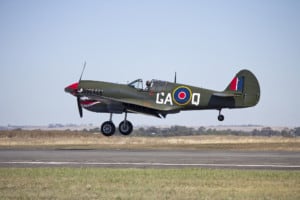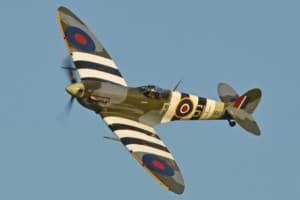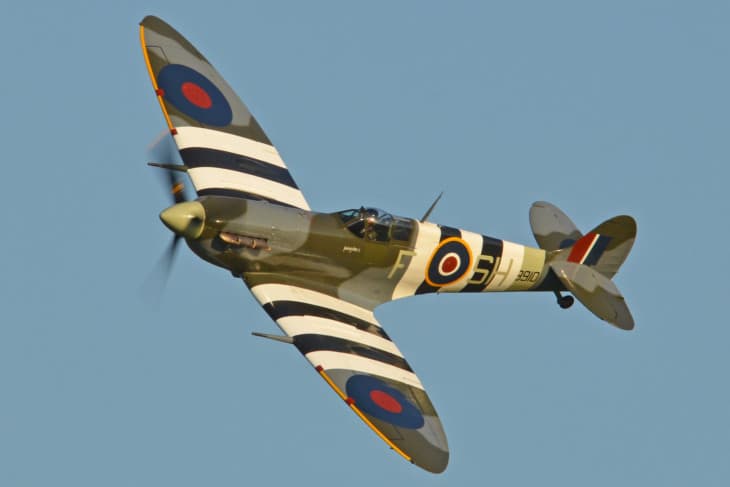It isn’t easy to decide the winner when comparing P-40 Warhawk vs Spitfire in a dogfight. They’re both excellent fighters in their own right. This guide will attempt to provide a clear victor in this matchup.
| Aircraft: | Curtiss P-40 Warhawk | Supermarine Spitfire |
|---|---|---|
| Photo: |
 |
 |
| Country: | United States | United Kingdom |
| Manufactured: | from: 1939 to: 1944 | from: 1938 to: 1948 |
| ICAO: | P40 | - |
| Price: | $0.045 million | $0.016 million |
| Avionics: | - | - |
| Engine: | 1x Allison V-1710-39 | 1x Rolls-Royce Merlin 45 V-12 |
| Engine Type: | Piston | Piston |
| Power: | 1,240 horsepower | 1,470 horsepower |
| Max Cruise Speed: |
318 knots 589 Km/h |
320 knots 593 Km/h |
| Approach Speed (Vref): | 83 knots | 68 knots |
| Travel Range: |
622 Nautical Miles
1,152 Kilometers |
960 Nautical Miles
1,778 Kilometers |
| Fuel Economy: | - | - |
| Service Ceiling: | 29,000 feet | 37,000 feet |
| Rate of Climb: |
2100 feet / minute 10.67metre / second |
2600 feet / minute 13.21metre / second |
| Take Off Distance: | - |
306 metre 1,003.92 feet |
| Landing Distance: | - |
242 metre 793.95 feet |
| Max Take Off Weight: |
4,173 Kg 9,200 lbs |
3,039 Kg 6,700 lbs |
| Max Landing Weight: |
3,862 Kg 8,514 lbs |
3,000 Kg 6,614 lbs |
| Max Payload: |
910 Kg 2,006 lbs |
500 Kg 1,102 lbs |
| Fuel Tank Capacity: |
157 gallon 594 litre |
102 gallon 386 litre |
| Baggage Volume: | - | - |
| Seats - Economy: | 1 seats | 1 seats |
| Seats - Business Class: | - | - |
| Seats - First Class: | - | - |
| Cabin Height: | - | - |
| Cabin Width: | - | - |
| Cabin Length: | - | - |
| Exterior Length: |
10.15 metre 33.30 feet |
9.12 metre 29.92 feet |
| Tail Height: | 3.77 metre - 12.37 feet | 3.48 metre - 11.42 feet |
| Fuselage Diameter: |
1 metre 3.28 feet |
0.9 metre 2.95 feet |
| Wing Span / Rotor Diameter: |
11.36 metre 37.27 feet |
11.23 metre 36.84 feet |
| Wing Tips: | No Winglets | No Winglets |
| More Info: | Curtiss P-40 Warhawk | Supermarine Spitfire |
|
Data presented is for entertainment purposes and should not be used operationally.
|
Other Curtiss P-40 Warhawk comparisons:
Other Supermarine Spitfire comparisons:
About the Curtiss P-40 Warhawk
The P-40 Warhawk was a type of fighter aircraft widely used by the United States and other Allied nations during World War II. Designed by legendary aircraft company Curtiss-Wright, this rugged plane featured advanced technology and powerful engines that suited it well for all combat scenarios.

Why was it developed and built?
The P-40 Warhawk was built as an all-purpose fighter aircraft. Its rugged construction allowed it to perform well in various conditions, from high-altitude dogfights to low-altitude bombing runs against ground targets.
The Warhawk’s powerful engine made it fast and maneuverable, giving its pilots an edge on the battlefield. But perhaps its most valuable design feature was its onboard weaponry, which included machine guns for air combat and bombs for ground attacks.
What purpose did it serve?
Not only did the P-40 Warhawk play a key role in the Allied fight against Nazi Germany and Japan, but it also saw continuous use throughout the rest of the 20th century due to its reliability and ease of maintenance.
Today, many people regard this legendary aircraft as an essential piece of military history that played a crucial role in helping to defeat fascism across the world.
About the Supermarine Spitfire
The legendary Spitfire aircraft served as an iconic symbol of Britain’s fighting spirit and ingenuity during WWII. With its impressive speed, maneuverability, and firepower, the Spitfire could take on many missions and prove incredibly versatile in any combat scenario.

Despite its relatively limited production numbers, the Spitfire has become one of the most famous fighter planes. It continues to inspire reverence and admiration among aviation enthusiasts today.
Whether you’re interested in military history or want to experience what it was like to fly this legendary piece of machinery, a Spitfire ride is an unforgettable experience.
Why was it developed and built?
Developed by British designer Reginald Mitchell in the late-1930s, this highly-adaptable aircraft played an instrumental role in helping the Allied forces defeat the Nazis and win the war.
Whether battling Nazi forces on land or sky or achieving a new level of technical prowess in flight, one thing is clear: the Spitfire forever changed how we think about flight and war.
What purpose did it serve?
The purpose of the aircraft Spitfire was multifaceted.
- It served as a powerful military weapon, helping to defend Britain against enemy invasion during World War II.
- The Spitfire played an essential role in the development of air travel, pushing aviation technology’s speed and engine power limits.
- And finally, it became a symbol of British innovation and resilience in the face of adversity, embodying all that was great about the “spirit of Britain.”
How are the P-40 Warhawk and Spitfire different?
The P-40 Warhawk and Spitfire were iconic combat aircraft extensively used during World War II. While they were both similar in many ways, there were also several key differences between the two planes.
- The P-40 was more heavily armored, making it better for higher-intensity dogfights with enemy fighters.
- Additionally, the P-40 had considerably better range and altitude capabilities – enabling it to fly at altitudes that the Spitfire could not reach.
- Finally, the P-40 was powered by a single engine, while the powerful twin engines of the Spitfire allowed it to achieve far greater speeds.
These differences made each plane ideal for specific combat situations, helping them play an essential role in allied victories throughout WWII.
How are the P-40 Warhawk and Spitfire similar?
Both were built by British and American aviation companies, and they shared many common features, including powerful engines, a single-engine design, and an emphasis on maneuverability.
- While both fighters possessed excellent speed capabilities, the P-40 Warhawk had better speed at high altitudes than the Spitfire.
- Both planes had wide wings that helped to emphasize their aeronautical agility.
- The Spitfire’s wings were slimmer than those of the P-40 Warhawk.
Thus, although it is tempting to see them simply as reflections of each other, we must remember that these often underrated warbirds also had their unique histories and distinctive strengths. Do you know how many years a plane lasts?
What’s better about the P-40 Warhawk?
The P-40 Warhawk is one of the most well-known fighter aircraft in history, with a production run spanning over ten years and thousands of planes manufactured.
- This success is due, at least in part, to the many advantages that the P-40 had over its competitors.
- Among these was its rugged construction, which made it highly resistant to damage from combat and mechanical failure.
- It also featured good range and maneuverability, allowing it to compete effectively even with faster planes.
- Perhaps most important for military pilots, however, was the Warhawk’s impressive firepower, with a total of six machine guns making it much better equipped than other fighters of its time.
In short, there were many reasons why the P-40 became such a successful plane during World War II and beyond. Whether you’re interested in strategy or engineering, there’s something about this fighter that will surely inspire you!
What’s better about the Spitfire?
Many things make the Spitfire aircraft a superior choice to other airplanes.
- To begin with, the Spitfire is crafted from a light yet sturdy metal alloy, which helps to reduce its overall weight and fuel consumption, allowing it to fly for longer periods at faster speeds than comparable aircraft.
- Additionally, the Spitfire has a powerful engine that allows it to accelerate when needed and maneuver deftly in tight spaces.
- Moreover, this aircraft features an advanced wing design that maximizes stability and control in even the most challenging flying conditions.
P-40 Warhawk vs Spitfire: Who’s The Winner?
The P-40 Warhawk and Spitfire aircraft were both developed during the tumultuous period of World War II.
While most people agree that the Spitfire was a better fighter craft, there is plenty of evidence to suggest that the P-40 Warhawk was also a formidable competitor in aerial combat.
Despite missing out on key features compared to its competitor, the P-40 Warhawk remains a powerful force in aerial combat history and deserves recognition alongside other legendary fighters like the Battle of Britain’s Supermarine Spitfire.
Conclusion
In summary, the P-40 Warhawk and Spitfire aircraft were essential during World War II. The P-40 Warhawk was known for its rugged construction, while the Spitfire was lauded for its advanced wing design.

